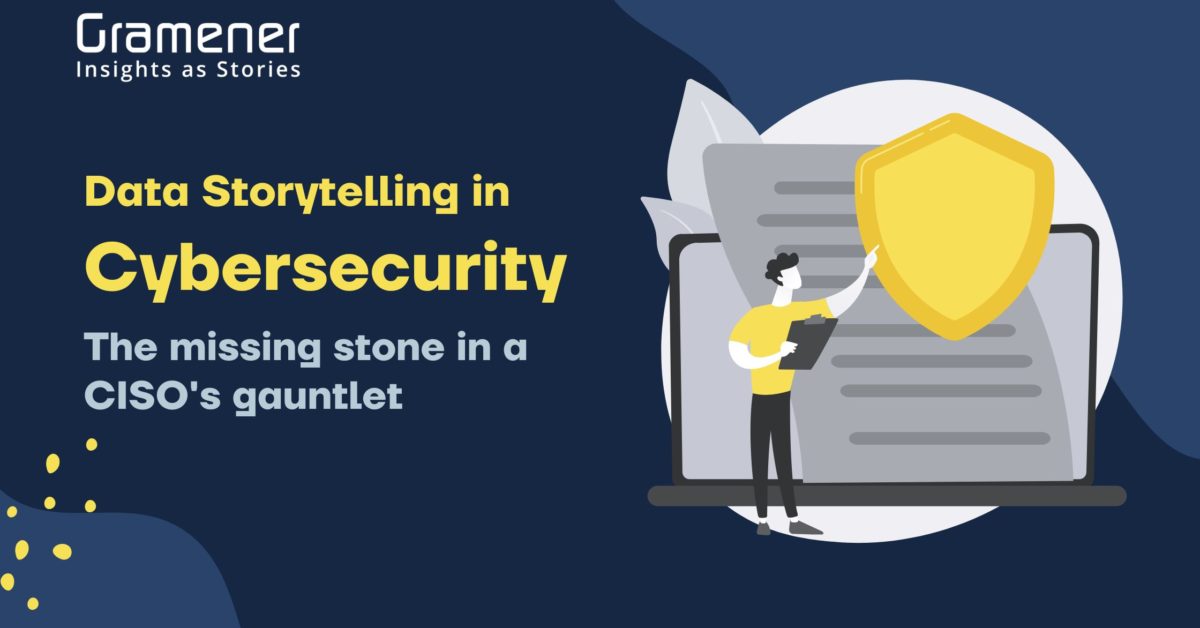Storytelling can inspire, engage and empower. It can also lend a fresh perspective to a topic or subject like cybersecurity, making it relatable to the audience. It can invoke the desired response by connecting with the audience. CIOs and CISOs working with world-class cybersecurity analytics solutions and teams are missing the storytelling piece in their puzzle. Let’s find out how data storytelling in cybersecurity can help CIOs and CISOs.
Table of Contents
Effective Data Storytelling in Cybersecurity
But what constitutes good storytelling? It involves asking the following key questions –
The Objective
What objective, or purpose, is the story trying to achieve? Every story should have a point, and points are conveyed better using stories.
A point comprises of an objective logic or reason that appeals to the analytical left hemisphere of our brain. The story makes the point more appealing to the emotional or right hemisphere of our brain. Together, they make the story and its point memorable, leading to better recall.
The Audience
Who will benefit the most from your information? Identifying the audience will help establish the narrative and define its flow. It will also enable you to understand how the audience will use the information you share and how it will benefit them long term.
A Relatable Story
We remember and connect at a personal level with stories we identify with. Using anecdotes that your audience can easily relate to will imprint your message in their minds.
A simple message is easy to recall. A complex or dense message does not leave a lasting impression, and audience members will quickly forget what they need help understanding.
Call to Action
A successful story spurs its audience to action. It will tell the audience what they can do next and the future course of action. A well-told story ends with a call to action, in this case, specific to cybersecurity.
Sometimes, even the best storytellers get carried away with their narrative and lose sight of their end goal – to get their audience to take action about cybersecurity. It is important not to stray too far away from the main point of the story and ensure that the audience does not get distracted by the main message.
What Qualities Distinguish a Compelling Data Story?
Data storytelling comprises of the same narrative elements as any other form of storytelling – conflict resolution, setting, and characters.
It can be best illustrated using an example – a data scientist has recently discovered that a social media post highlighting the negative impact of his company’s policies on the environment has gone viral. This has caused a steep decline in sales among customers aged 20 – 25.
It is his responsibility to build a data story surrounding these events using the following key story elements:
Characters
It is essential to define the key players or stakeholders in a data story, even if they are not a part of the presentation. For instance, in this scenario, the key stakeholders include environmentally conscious consumers between the ages of 20 to 25 and the internal team of the company that is handling the issue.
Setting
This data story aims to showcase the decline in sales among customers between the ages of 20 to 25. This can be presented using a data visualization that shows a drop in sales across audience types, highlighting the sharpest decline among young users.
Conflict
This identifies the root issue. Tens of thousands of young customers stopped using your product after viewing a viral social media post. The data story can incorporate research that shows how sustainable products generate more revenue than unsustainable ones.
Use visualizations to highlight the unsustainable business practices to show your team what led to customers rejecting your product.
Resolution
Using this data, propose a long-term solution to action sustainable business processes. Public relations and marketing can help communicate and promote this transformation across all customer segments.
Using visualization, show the RoI from implementing sustainable manufacturing practices and how it will help you earn more customers and generate revenue from the rapidly expanding environmentally conscious market segment.
A good data story can effectively communicate a narrative, using visualization to offer a step-by-step walkthrough to the audience.
Role of Data Storytelling in Cybersecurity
Using data storytelling in cybersecurity can help convey vital information in an appealing and exciting manner. Concepts that are communicated via stories are easier to remember and understand. There is a need for data storytelling for cybersecurity because of the following reasons –
Higher Recall Value
There have been many studies that have corroborated the fact that people recall stories more than statistics. Understanding the genesis and significance of threat figures can help us remember them longer than merely knowing the number.
Generates More Interest
The art of storytelling satiates our natural curiosity. It nourishes our desire to know more and possess more information. These biological traits draw us to exciting tales, like a moth to a flame. Data stories can help pique our interest and call attention to cybersecurity matters.
Brings More Value to AI Analytics
Many organizations use AI-based analytics tools instead of traditional excel sheets or dashboards. These tools have transformed the way cybersecurity information is accessed by users and reports are generated.
Contextual analysis helps these tools interpret numbers more easily and derive valuable insights. Embedding data storytelling in cybersecurity can improve the retention of threat information in a narrative and help sell the solution to more people.
Conclusion
Numbers, or figures, can help us understand what and why behind an activity. However, connecting the dots or seeing the bigger picture can sometimes take work.
The benefit of data storytelling in cybersecurity is that it gives voice to threat data through a narrative and provides clarity. The evolution of the raw data from a handful of numbers on a report or spreadsheet to its final version, providing crucial business insights, is more powerful.
Contact us if you are looking to accentuate your cybersecurity efforts with our powerful data storytelling interface.

